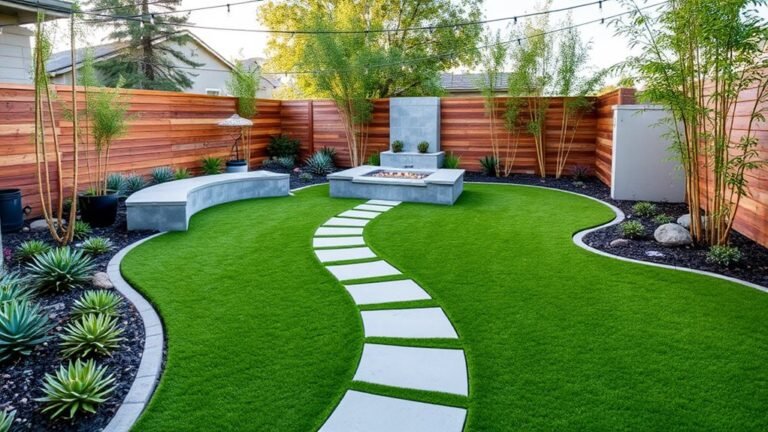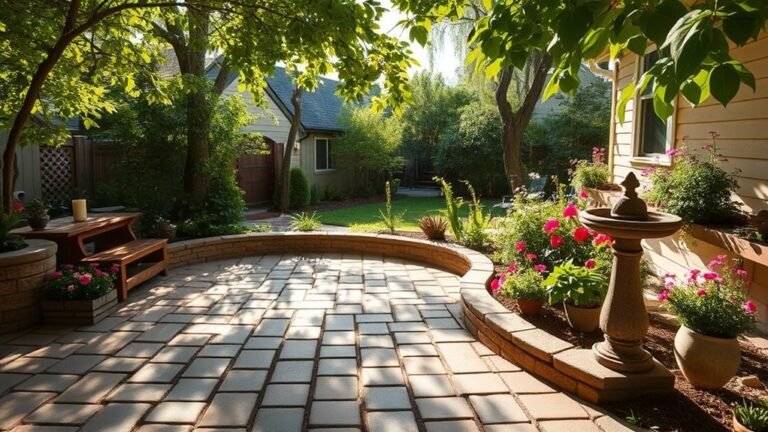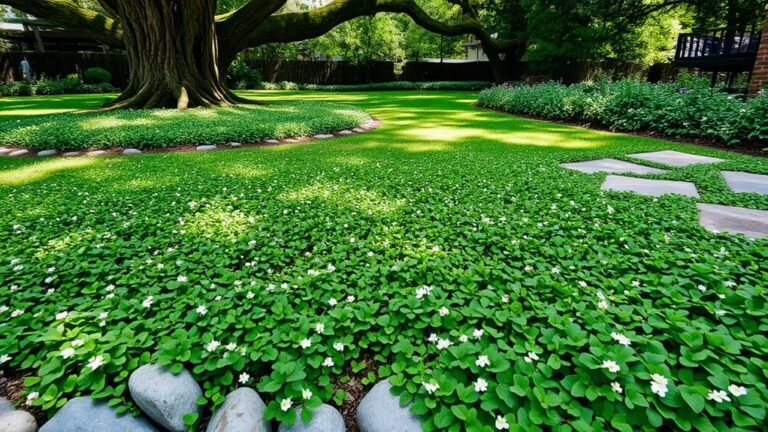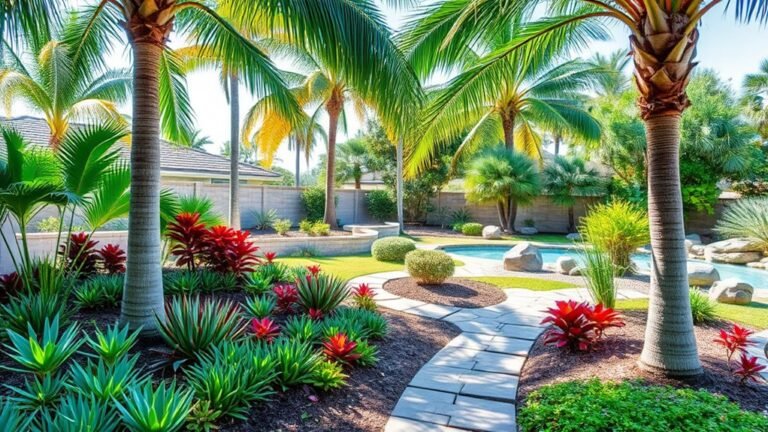20 Backyard Xeriscape Ideas for Water Conservation

If you want to reduce water usage while maintaining a beautiful backyard, consider xeriscaping as a sustainable option. Start by selecting native plants suited to your region and consider hardscape elements for added durability.
Incorporating features like rock gardens or drip irrigation can enhance your space and contribute to water conservation. Explore these ideas to create an eco-friendly oasis that blends aesthetics with functionality.
Native Plant Gardens

Designing a native plant garden not only enhances your landscape but also supports local ecosystems.
Picture walking through a yard filled with colorful blooms that thrive with minimal maintenance! Native plants are well-suited to your local climate, making them more drought-resistant and requiring less water than high-maintenance exotics.
By incorporating native species, you'll reduce your workload—no more daily watering! Additionally, these plants attract pollinators like bees and butterflies, offering you a front-row view of nature's activity—without the cleanup!
When choosing plants, research the best varieties for your area. Opt for drought-tolerant species like coneflowers, asters, and penstemons to create a vibrant display.
Don't forget to include grasses, which sway elegantly in the wind.
Rock Gardens

Native plant gardens provide an ideal foundation for incorporating rock gardens into your outdoor space.
Imagine a beautifully layered composition of stones, boulders, and native plants thriving on minimal water. Design a rock garden that enhances your native plants, creating a stunning habitat that supports local wildlife.
Choose stones of various shapes and sizes for a natural, scattered appearance—nature thrives on a bit of chaos!
Position the rocks thoughtfully, letting some stand out while others settle into the earth.
Select hardy plants that thrive in dry conditions, like vibrant wildflowers, low-growing ground covers, and ornamental grasses that sway in the breeze.
As these plants flourish, your rock garden will attract butterflies and bees.
With a touch of creativity and humor, your rock garden will conserve water and become the envy of the neighborhood!
Drought-Tolerant Succulents

Incorporating drought-tolerant succulents into your xeriscape enhances both beauty and efficiency. These hardy plants offer vibrant colors and unique shapes, making your yard resemble a desert oasis while requiring minimal water—an ideal choice for water-saving goals.
Consider varieties like the playful burro's tail or classic aloe vera, each contributing its own flair. Plant them in well-draining soil and watch them thrive in hot months.
For added interest, mix different types for a striking display of textures and hues. Succulents are resilient, thriving in drought conditions, allowing you to spend less time worrying and more time enjoying your space.
Plus, your eco-friendly gardening will impress neighbors. Start experimenting with these amazing plants and effortlessly transform your backyard into a stunning xeriscape paradise. Happy planting!
Gravel Pathways

Gravel pathways enhance the functionality and charm of your xeriscaped backyard, offering easy navigation and an inviting atmosphere. They're low maintenance and come with several benefits:
- Versatile Design: Select from various colors and sizes to match your style.
- Weed Control: A layer of landscape fabric beneath the gravel minimizes weed growth.
- Drainage Benefits: Gravel efficiently drains water, reducing puddles and erosion, benefiting your plants.
- Affordable: Gravel is a budget-friendly and easy-to-install option compared to other hardscaping materials.
Creating a gravel pathway is an enjoyable project that allows you to express your style, whether you prefer a simple winding path or a more structured design.
It's also an opportunity to showcase your favorite drought-tolerant plants. So gather your materials, get creative, and enjoy your new fabulous pathway!
Drip Irrigation Systems

To create a water-efficient landscape, consider installing a drip irrigation system, which delivers water directly to plant roots. This method saves water and prevents overwatering, ensuring your plants don't feel like they're in a swamp!
Drip irrigation utilizes customizable tubing and emitters, eliminating the hassle of tangled hoses. Plus, you can set it on a timer, allowing you to enjoy your coffee while your plants receive just the right amount of moisture.
With careful planning, each plant can get its fair share of water without over-saturating its neighbors—it's like giving your garden a refreshing spa day!
Many drip systems are also easy to install for beginners. So, why not start your drip irrigation journey? Your garden—and your water bill—will appreciate it! Let's make watering efficient and fun!
Ornamental Grasses

Ornamental grasses can transform your backyard into a stunning, low-maintenance oasis.
These versatile plants add texture and movement while requiring minimal water once established. Their graceful sway in the wind creates a relaxing atmosphere, ideal for those seeking low-maintenance landscaping.
Consider these benefits of adding ornamental grasses to your yard:
- Water-efficient: They thrive on minimal irrigation.
- Diverse varieties: Countless shapes, sizes, and colors ensure a perfect match for your space.
- Wildlife-friendly: Many species attract beneficial insects and birds, enhancing your garden's liveliness.
- Four-season interest: They remain visually appealing year-round, even in winter.
Xeriscape Ground Covers
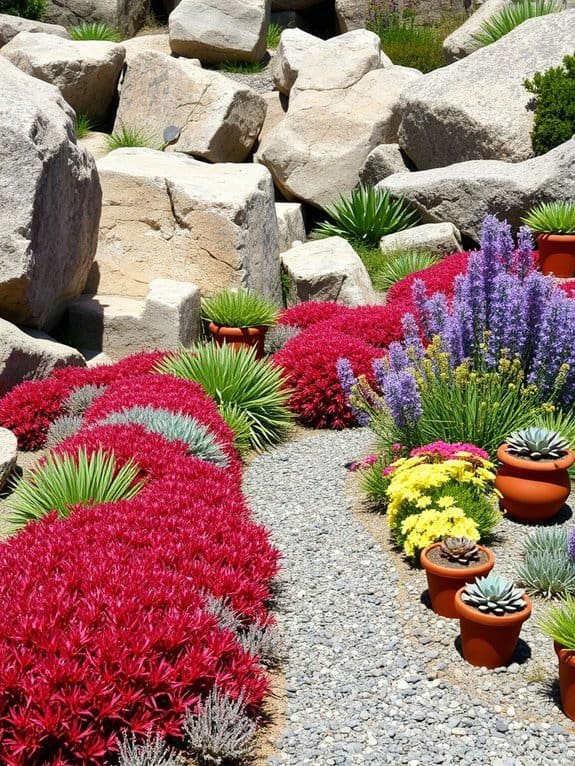
Xeriscape ground covers are a fantastic solution for a beautiful, water-efficient landscape.
Picture vibrant colors and textures in your yard while conserving water—sounds appealing, right? Plants like creeping thyme, sedum, and chamomile spread quickly, providing a lush appearance with minimal water needs.
Not only do they save water, but they also prevent weeds from invading your garden. Who wouldn't want a natural weed-blocking solution?
Additionally, these ground covers soften hard surfaces like paths and patios, enhancing the overall atmosphere.
If you haven't yet considered ground covers, now is the time! Their low maintenance allows you to enjoy your backyard oasis instead of spending time watering.
Resistant to drought, these hardy plants thrive in arid conditions. Choose a few varieties that catch your eye, and watch them create a colorful tapestry across your yard.
Your drought-tolerant landscape will impress both you and your neighbors. Happy xeriscaping!
Raised Xeriscape Beds

Raised xeriscape beds enhance your gardening experience while promoting water efficiency.
These elevated gardens save water and provide a unique aesthetic, allowing you to showcase your favorite drought-tolerant plants.
Here are some key benefits of raised xeriscape beds:
- Soil Control: Select the ideal soil mix for your plants' health.
- Drainage Improvement: Elevation aids drainage, preventing waterlogging and root rot.
- Easier Access: Raised beds help you garden without straining your back and knees.
- Pest Management: Keep pests away, ensuring healthier plants.
Building raised xeriscape beds can be an enjoyable weekend project.
Gather materials and get creative!
You'll love the process and the impressive results—who knew water conservation could be so enjoyable?
Rain Gardens

Enhancing your landscape while managing stormwater runoff can be achieved by creating a rain garden. These delightful gardens conserve water by collecting rain instead of allowing it to rush away.
Start by selecting a low area in your yard where water tends to gather. Dig a shallow basin and plant native species that thrive in wet conditions. These plants not only absorb water but also attract butterflies and birds, adding color to your garden.
To ensure your rain garden can manage heavy rainfall, incorporate gravel for better drainage.
You'll enjoy watching water disappear into the plants rather than pooling or running off.
Edible Xeriscaping

If you want to blend aesthetics with functionality in your garden, consider edible xeriscaping. It allows you to create a vibrant oasis while conserving water and enjoying fresh produce just steps away from your kitchen!
Here are some ideas for your edible xeriscape:
- Drought-tolerant herbs: Grow sage, rosemary, and thyme for low-water seasoning options.
- Fruit-bearing bushes: Blueberries and raspberries can add both color and flavor while thriving in dry conditions.
- Succulent vegetables: Kale and Swiss chard are visually appealing and require minimal water, ideal for xeriscaping.
- Cacti with fruit: Certain cacti bear edible fruits, adding whimsy to your edible landscape!
Permeable Paving Ideas

Transform your backyard into a sustainable and stylish space with three effective permeable paving ideas.
First, consider gravel or crushed stone, which allows rainwater to seep through while adding a rustic vibe. Mix in colorful stones for a personal touch.
Next, opt for permeable pavers, designed with gaps that let water flow through, allowing for chic, eye-catching designs that combine practicality with aesthetics.
Lastly, consider permeable concrete. It's strong and durable, with a porous nature to manage stormwater.
With creativity, you can incorporate patterns or textures that enhance your garden's look, setting trends among your neighbors!
Xeriscape Color Schemes

While xeriscaping is an excellent way to conserve water, selecting the right color scheme can turn your backyard into a stunning oasis. A little creativity can transform your landscape into a captivating masterpiece.
Consider these vibrant color schemes for your design:
- Desert Sunset: Warm reds, oranges, and yellows evoke a desert sunset, adding coziness.
- Cool Greens and Blues: Various shades of green paired with cool blues create a tranquil escape, ideal for relaxation.
- Earthy Neutrals: Browns and tans harmonize with nature, offering calm, understated elegance.
- Bright Accents: Infuse bright colors like fuchsia or lime green through flowers or garden art for a playful touch.
Mix and match these ideas to design a xeriscape that conserves water and wows visitors.
Happy designing!
Shade-Tolerant Plants

When designing your xeriscape, don't overlook shade-tolerant plants that thrive in low-light areas while conserving water. These green wonders flourish in spots under trees or structures where sunlight is limited.
Imagine a lush retreat filled with ferns, hostas, and astilbes.
Ferns provide a feathery touch, while hostas showcase an array of colors and shapes—like nature's art gallery! Astilbes add elegance with fluffy plumes and vibrant hues, perfect for brightening shady corners.
By incorporating these plants into your landscape, you're not only beautifying your yard but also conserving water, as they thrive on minimal moisture and require less irrigation.
Picture your friends admiring your stunning garden as you humorously boast about your low-maintenance "shade oasis." Embrace shade-tolerant plants and transform even the dimmest spots into a vibrant haven!
Water Features

Water features enhance xeriscape designs, adding aesthetic appeal and a soothing ambiance. The sound of trickling water creates a natural soundtrack for your outdoor space.
Consider these ideas when incorporating water elements:
- Bird Baths: Attract birds with a stylish bird bath, offering them a refreshing spot to splash while you enjoy their songs.
- Container Water Gardens: No pond? No problem! Use decorative pots for aquatic plants to create a mini water garden in any part of your yard.
- Fountains: A small solar fountain adds movement and sound to your garden while conserving energy—it's a win-win!
- Rain Chains: Swap standard downspouts for rain chains, which guide rainwater and create a beautiful cascading waterfall effect.
Always prioritize conservation. Surround your water features with native plants to minimize maintenance and water use.
Let your backyard flow with creativity!
Mulching Techniques

After enhancing your xeriscape with soothing water features, consider effective mulching techniques to support your garden's health.
Mulch acts as a protective blanket for plants, keeping soil cool, retaining moisture, and suppressing weeds.
You can choose from various mulch types, such as organic options like bark chips, straw, or shredded leaves, or opt for stone and gravel for a modern look. Organic mulch nourishes the soil as it decomposes and adds charm to your space.
Spread it about three inches deep to adequately cover the soil without suffocating your plants.
Regularly refresh your mulch to keep your garden looking tidy and replenish nutrients. If you spot a worm, don't worry—they're beneficial!
With these mulching techniques, you'll cultivate a thriving xeriscape that conserves water and looks fantastic. Happy mulching!
Wildlife-Friendly Plants
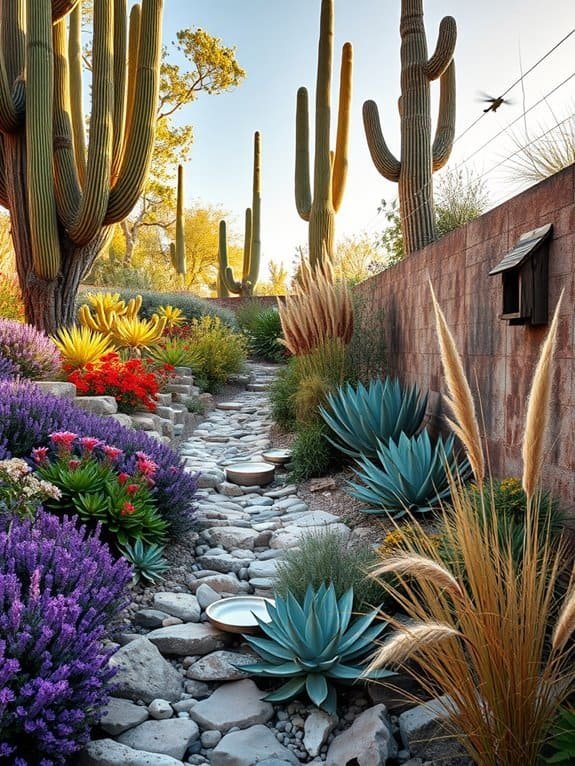
To create a wildlife-friendly xeriscape, choose native plants that thrive in your climate and attract beneficial wildlife.
Think of it as a garden party for nature, filled with butterflies, bees, and birds.
Here are some excellent options for your backyard:
- Milkweed: This hardy plant attracts Monarch butterflies.
- Coneflower: Its vibrant blooms provide nectar for pollinators and seeds for birds in the fall.
- Lavender: This fragrant plant attracts bees and enhances your garden's beauty.
- Sedum: A drought-resistant succulent that nourishes pollinators and wildlife.
Hardscape Elements

Incorporating hardscape elements into your xeriscape improves functionality and aesthetics while minimizing water use.
Consider adding pathways, patios, or decorative stones to create visually appealing spaces for relaxation. These elements require no watering and are easy to maintain.
Gravel or decomposed granite make stylish, eco-friendly pathways that aid drainage.
Stone benches and raised beds provide structure and cozy areas for gatherings, perfect for enjoying a sunlit afternoon.
Retaining walls help define spaces and stabilize soil, particularly on slopes.
Adding mulch creates a lovely contrast, enhancing the overall design.
Composting Benefits
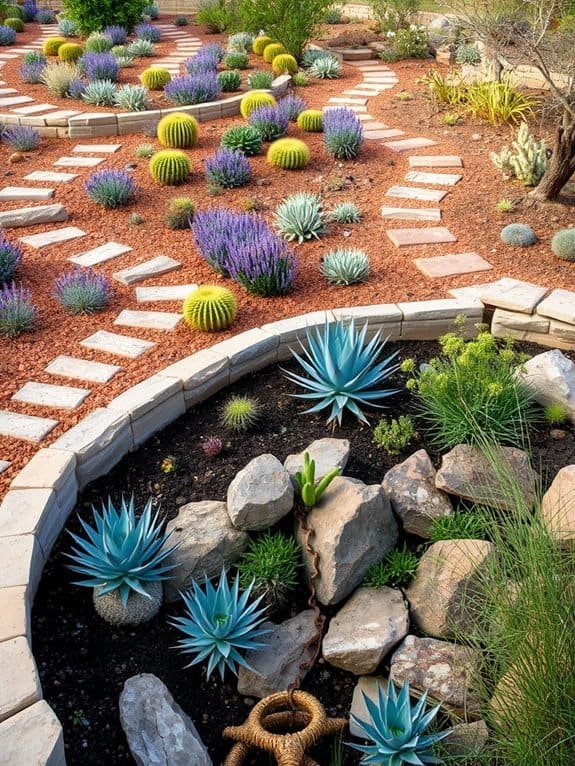
Composting can transform your xeriscape garden into a thriving ecosystem. By recycling kitchen scraps and yard waste, you not only reduce landfill waste but also create nutrient-rich compost for your plants.
Your soil will greatly benefit!
Here are some key advantages of composting:
- Enhanced Soil Quality: Compost enriches the soil with essential nutrients, improving its structure and fertility, which aids plant growth.
- Moisture Retention: It allows soil to retain water better, minimizing the need for irrigation—ideal for xeriscaping.
- Pest Control: Healthy soil fosters strong plants that are less prone to pests and diseases, allowing your garden to thrive naturally.
- Eco-Friendly: Composting helps the environment by reducing waste and promoting a sustainable lifestyle.
Xeriscaping With Boulders

When designing your xeriscape, consider using boulders as focal points that enhance your garden's natural beauty.
These natural sculptors add character and visual interest, guiding the eye through your landscape.
Group several boulders to mimic natural rock formations, creating a tone of rugged elegance. They can serve as a backdrop for vibrant desert plants, providing stunning contrast.
Boulders also promote water conservation by reducing erosion and retaining moisture in the soil. In addition to their aesthetic appeal, they support sustainable gardening practices.
Sprinkle native plants, like succulents or wildflowers, around your boulders to add bursts of color.
Embrace these giants in your landscaping to create an inviting, sustainable retreat that impresses without requiring heavy lifting on your part!
Seasonal Interest Planning

To maintain a vibrant xeriscape year-round, select plants that provide seasonal interest with blooms or color changes. This ensures your outdoor space remains visually appealing throughout the year.
Consider these ideas:
- Spring Bloomers: Choose perennials like bleeding hearts or tulips for cheerful colors as winter fades.
- Summer Stars: Pick drought-tolerant plants such as lavender or agave that hold striking shapes in the heat.
- Fall Foliage: Opt for deciduous trees or shrubs like sumac that shift to fiery reds and oranges for an eye-catching autumn display.
- Winter Interest: Incorporate evergreens or unique bark textures from plants like birch to add character during gray months.
Frequently Asked Questions
What Is Xeriscaping and How Does It Help With Water Conservation?
Xeriscaping's all about designing your landscape to thrive in dry conditions, using plants that naturally require less water.
Instead of a thirsty lawn, you'll enjoy beautiful, drought-resistant flora that's low-maintenance and eco-friendly.
Think cacti, succulents, and native plants! Not only does it save water, but it cuts down your watering bills too!
Plus, you'll get to show off a unique garden that's the envy of your neighborhood. Who wouldn't love that?
How Much Initial Investment Is Required for a Xeriscape Garden?
They say, "You gotta spend money to make money," and that applies to your xeriscape garden too!
Initial investments can vary, but typically, you're looking at a few hundred to several thousand bucks, depending on size and plant choices.
Think of it as a lovely long-term savings plan for your water bill!
You'll save time, money, and maybe even gain a green thumb in the process.
Plus, it's fun to get your hands dirty!
Can I Convert My Traditional Lawn to Xeriscaping?
Absolutely, you can convert your traditional lawn to xeriscaping!
Start by removing that grass, which can feel like saying goodbye to an old friend.
Next, pick native plants that love your climate—they'll thrive with less water.
Add some mulch to keep the soil cozy and moist.
Finally, think about fun features like paths or rock gardens to spice things up.
You'll save water and create a beautiful space that's uniquely yours!
What Maintenance Is Involved in a Xeriscape Landscape Design?
Think of your xeriscape as a vibrant, low-maintenance quilt stitched with drought-resistant plants.
To keep it looking fabulous, you'll want to water deeply but less frequently, mainly during dry spells.
Pulling weeds is like a little gardening workout, so get ready to flex those muscles!
Trimming and mulching helps too, keeping everything neat and cozy.
Don't worry, it's a fun journey that saves water while creating a stunning landscape you'll love!
How Do I Select the Right Xeriscaping Plants for My Climate?
Choosing the right xeriscaping plants for your climate is essential!
Start by checking your USDA plant hardiness zone, which tells you what thrives in your area.
Look for drought-tolerant varieties that match your sunshine levels and soil type.
Native plants are your best friends—they're adapted to local conditions and require less care.
Don't forget to mix textures and colors for a vibrant look.
A little planning now means a beautiful, low-maintenance garden later!
Conclusion
Transform your backyard into a xeriscape wonderland that conserves water. By selecting the right plants and incorporating smart features, you create a vibrant habitat filled with color and life.
Embrace the sustainable journey of gardening, where every rock and succulent has its own story. A beautiful garden can thrive without excessive watering—let it flourish using nature's gifts!

